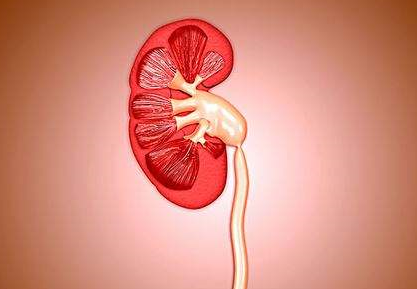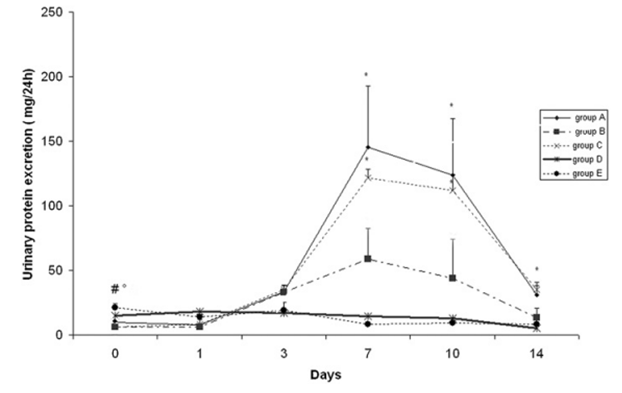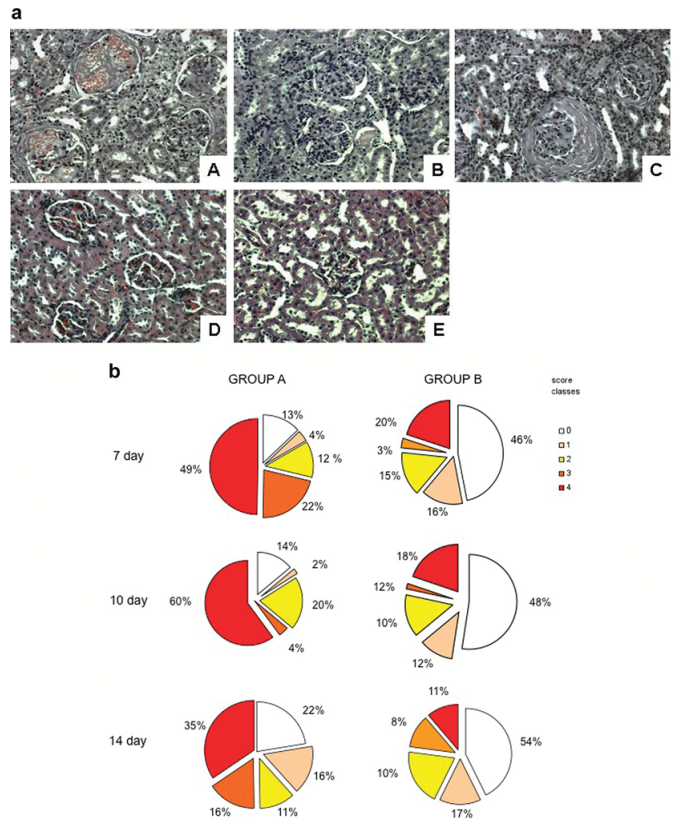Glomerulonephritis Models
Glomerulonephritis (GN) is an autoimmune disease that induces inflammation within the glomerulus and other compartments of the kidney. The clinical features encompass the formation of proteinuria and haematuria as well as low calculated glomerular filtration rate (GFR). Autoimmunity, cancer and structural abnormalities within kidney are involved in the pathogenesis of GN. However, the pathological mechanism of GN is still unclear. In addition, GN has been known as a common cause of chronic kidney disease (CKD) worldwide. It is associated with severe morbidity and thus represents a major socioeconomic health problem. Therefore, it is necessary for scientific research to look into an effective therapy for this significant clinical disease. Creative Bioarray specializes in providing customized pharmacodynamic research services to help customers assess the efficacy of drug candidates against glomerulonephritis and study the associated pathological mechanisms through glomerulonephritis models.
 Figure. 1. Nephritis
Figure. 1. Nephritis
Creative Bioarray provides you with Glomerulonephritis models including but not limited to:
- Acute Puromycin Aminonucleoside (PAN) Model
- Anti-Thy1 Induced Nephritis Model
- Cationic BSA Induced Immune Complex Glomerulonephritis Model
- Haymann Nephritis Model
- IgA Nephropathy (IgAN) Model
Our Capabilities
- We utilize Glomerulonephritis models to perform PK/PD experiments on drug candidates.
- We assess the severity of GN through glomerular damage score system.
- We evaluated the deposition of lg and C3 complement via IHC.
- We evaluate various cytokines through IHC, ELISA, etc.
Assays available
- PK/PD blood collections
- Detection of Blood creatinine
- BUN
- Proteinuria
- Histopathological evaluation
With extensive experience in the field of GN, we are confident to help you to overcome any upcoming challenges. Our experts are fully capable of customizing our protocols and assays to meet your specific needs. With our help, we wish to facilitate your research with high efficiency.
Study examples
 Figure. 2. Urinary protein excretion rate in the experimental groups.
Figure. 2. Urinary protein excretion rate in the experimental groups.
 Figure. 3. Representative renal morphology in the experimental groups at day 10 (a), and the glomerular damage score in groups A and B (b).
Figure. 3. Representative renal morphology in the experimental groups at day 10 (a), and the glomerular damage score in groups A and B (b).
Quotation and ordering
If you have any special needs or questions regarding our services, please feel free to contact us. We look forward to cooperating with you in the future.
Reference
Rampino T, Gregorini M , Bedino G , et al. Mesenchymal stromal cells improve renal injury in anti-Thy 1 nephritis by modulating inflammatory cytokines and scatter factors[J]. Clinical Science, 2011, 120(1):25-36.
For research use only. Not for any other purpose.
Disease Models
- Oncology Models
-
Inflammation & Autoimmune Disease Models
- Rheumatoid Arthritis Models
- Glomerulonephritis Models
- Multiple Sclerosis (MS) Models
- Ocular Inflammation Models
- Sjögren's Syndrome Model
- LPS-induced Acute Lung Injury Model
- Peritonitis Models
- Passive Cutaneous Anaphylaxis Model
- Delayed-Type Hypersensitivity (DTH) Models
- Inflammatory Bowel Disease Models
- Systemic Lupus Erythematosus Animal Models
- Oral Mucositis Model
- Asthma Model
- Sepsis Model
- Psoriasis Model
- Atopic Dermatitis (AD) Model
- Scleroderma Model
- Gouty Arthritis Model
- Carrageenan-Induced Air Pouch Synovitis Model
- Carrageenan-Induced Paw Edema Model
- Experimental Autoimmune Myasthenia Gravis (EAMG) Model
- Graft-versus-host Disease (GvHD) Models
-
Cardiovascular Disease Models
- Surgical Models
- Animal Models of Hypertension
- Venous Thrombosis Model
- Atherosclerosis model
- Cardiac Arrhythmia Model
- Hyperlipoidemia Model
- Doxorubicin-induced Heart Failure Model
- Isoproterenol-induced Heart Failure Model
- Arterial Thrombosis Model
- Pulmonary Arterial Hypertension (PAH) Models
- Heart Failure with Preserved Ejection Fraction (HFpEF) Model
-
Neurological Disease Models
- Alzheimer's Disease Modeling and Assays
- Seizure Models
- Parkinson's Disease Models
- Ischemic Stroke Models
- Acute Spinal Cord Injury (ASCI) Model
- Traumatic Brain Injury (TBI) Model
- Hypoxic-Ischemic Encephalopathy (HIE) Model
- Tourette Syndrome (TS) Model
- Amyotrophic Lateral Sclerosis (ALS) Model
- Huntington's Disease (HD) Model
- Intracerebral hemorrhage (ICH) Models
- Schizophrenia Model
- Pain Models
-
Metabolic Disease Models
- Type 1 Diabetes Mellitus Model
- Type 2 Diabetes Mellitus Model
- Animal Model of Hyperuricemia
-
Nonalcoholic Fatty Liver Disease Model
- High-Fat Diet-Induced Nonalcoholic Fatty Liver Disease (NAFLD) Model
- Methionine and Choline Deficient (MCD) Diet-Induced Nonalcoholic Fatty Liver Disease (NAFLD) Model
- Gubra-Amylin NASH (GAN) Diet-Induced Nonalcoholic Fatty Liver Disease (NAFLD) Model
- Streptozotocin (STZ) Induced Nonalcoholic Fatty Liver Disease (NAFLD) Model
- High Fat Diet-Induced Obesity Model
- Diabetic Foot Ulcer (DFU) Model
- Liver Disease Models
- Rare Disease Models
- Respiratory Disease Models
- Digestive Disease Models
-
Urology Disease Models
- Cisplatin-induced Nephrotoxicity Model
- Unilateral Ureteral Obstruction Model
- 5/6 Nephrectomy Model
- Renal Ischemia-Reperfusion Injury (RIRI) Model
- Diabetic Nephropathy (DN) Models
- Passive Heymann Nephritis (PHN) Model
- Adenine-Induced Chronic Kidney Disease (CKD) Model
- Kidney Stone Model
- Doxorubicin-Induced Nephropathy Model
- Orthotopic Kidney Transplantation Model
- Orthopedic Disease Models
- Ocular Disease Models
- Skin Disease Models
- Infectious Disease Models
- Otology Disease Models